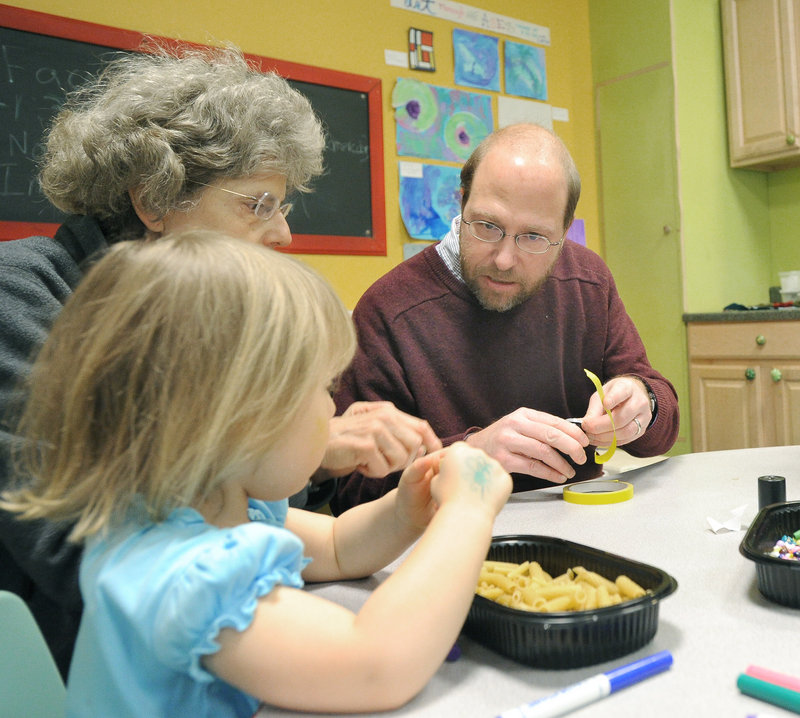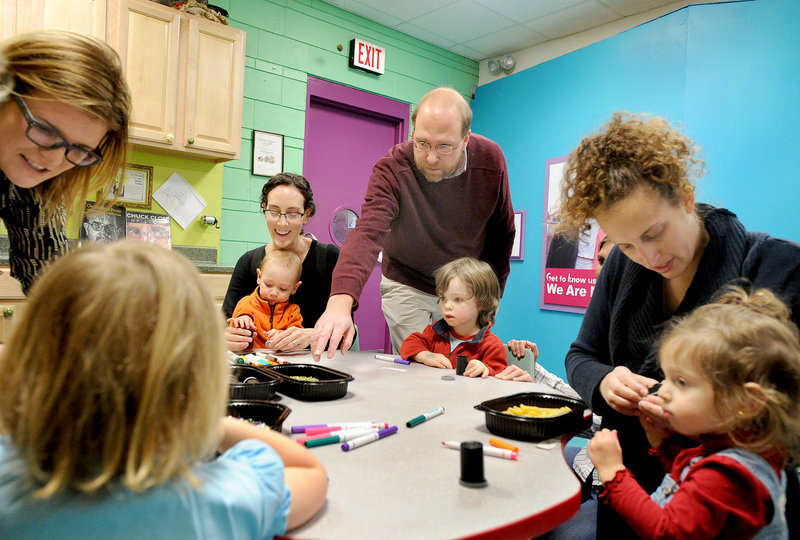PORTLAND – Louisa Donelson looked at her watch and saw that it was 10:15 a.m. She had just 15 minutes before leading a program for toddlers and preschoolers titled “Sound Exploration.”
“I’ve got a few minutes so I was going to start doing some measurement for this grant proposal,” said Donelson, 27, an educator at the Children’s Museum & Theatre of Maine. “I’ve got these cutouts of dolphins and porpoises to use.”
Cutouts of dolphins and porpoises? For a grant proposal?
I quickly learned that the job of educator at a children’s museum includes the intersection of different worlds — grants and fundraising, for instance, intersecting with the art and craft of drawing a dolphin. And then figuring a way to compare its length with, say, a school bus.
That’s what Donelson was working on. She was measuring long strands of yellow twine to correspond with dolphins. So we laid the twine on the floor of her office and measured 10 feet, the average length of a dolphin. Her plan was to tie the twine to a dolphin cutout so kids could see how long a dolphin is and then compare that to other things.
Donelson was making this nifty tool, and others, as part of her effort to win a grant that would allow her to do a marine mammals project with children on Peaks Island.
But soon, it was time to start the Sound Exploration program in the Explore Some More room in the museum. So the dolphins would have to wait.
Donelson pointed to a big plastic bin full of instruments and noisemakers — drums, bells, pots, pans, lids — and asked me to carry it down to the program area. We also took several containers of dried food — lentils, pasta, rice — plus some beads and some empty film canisters.
The idea was, Donelson told me, that the kids would get their hands on these various items and put them in the canister to create a sound maker. They’d get to feel different things, see what fits in the canister and then see a different use for macaroni or rice — making music instead of dinner.
“I really like figuring out ways to have kids look at things differently,” said Donelson, a Portland resident. “And the adults often learn something, too.”
Three-year-old Gianna Grabowski of Portland very carefully colored a label for her canister first, with me offering up color choices. Then I put several kinds of dried food in front of her, and she took a little of each.
It was fun for me to watch her brain work as she put some long pieces of penne pasta in the canister, saw that they stuck out, then took them out and replaced them with smaller pieces of pasta.
When she was done, I taped the canister shut, a little clumsily, then handed it to her. She smiled and wanted to show me what the finished product looked like.
It reminded me of some of the reasons Donelson said she likes her job. She gets to teach, to open children’s eyes to new things, but she doesn’t have to be an authority figure in any way.
“It’s sort of like I’m an adult peer. I can laugh with them, try to figure things out with them,” said Donelson. “And I always feel like I want to give my all with every child. I would feel bad at the end of the day if I felt I had been lazy with a child.”
Donelson told me she spends about half of her time with children doing programs, from music and art to science or nature. Some of her work is putting on programs outside of the museum, at schools and other venues.
Later, we went to sit in on another program, Dancing with Books, in the museum theater. It wasn’t Donelson’s program, but she wanted to observe, to look for ideas.
While we were there, we both adopted Donelson’s idea of being “adult peers,” so we danced with the kids. At one point I was curled up on the floor pretending to be a sleeping mouse, among a dozen kids and their caregivers doing the same thing.
One of the more unusual activities that Donelson has done at the museum involved having kids dissect owl pellets — the little nuggets of material that owls regurgitate. That way, children learn all about an owl’s environment, in a way they had probably never thought of before.
Donelson has to spend some of her time planning and preparing programs, trying to figure out what might get young minds engaged.
Whether it’s through music, art, or regurgitated owl pellets.
Staff Writer Ray Routhier can be contacted at 791-6454 or at:
rrouthier@pressherald.com
Send questions/comments to the editors.





Comments are no longer available on this story